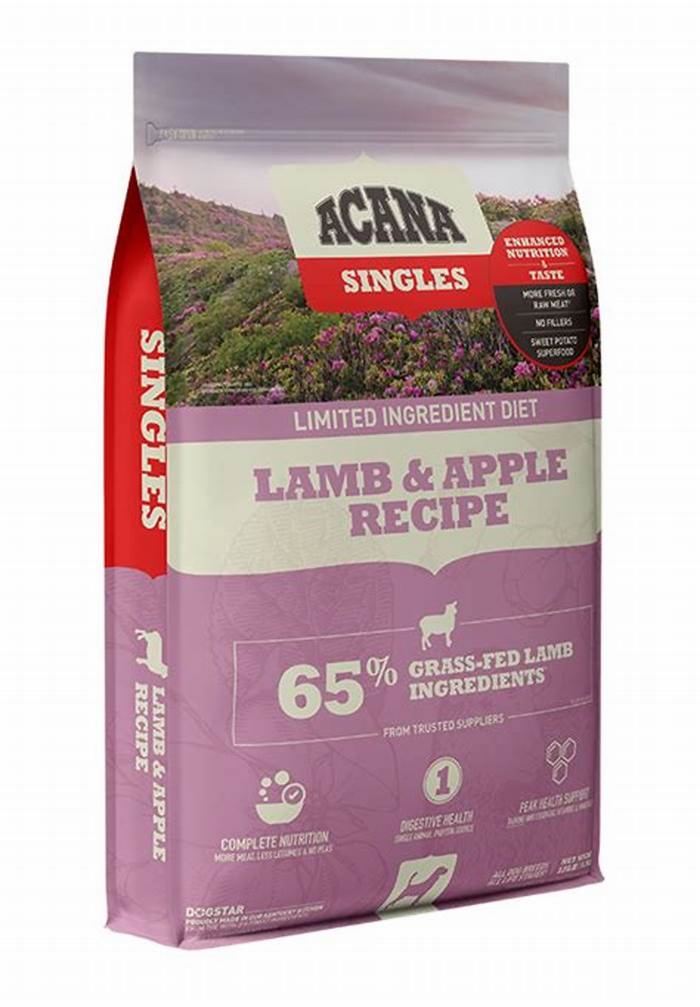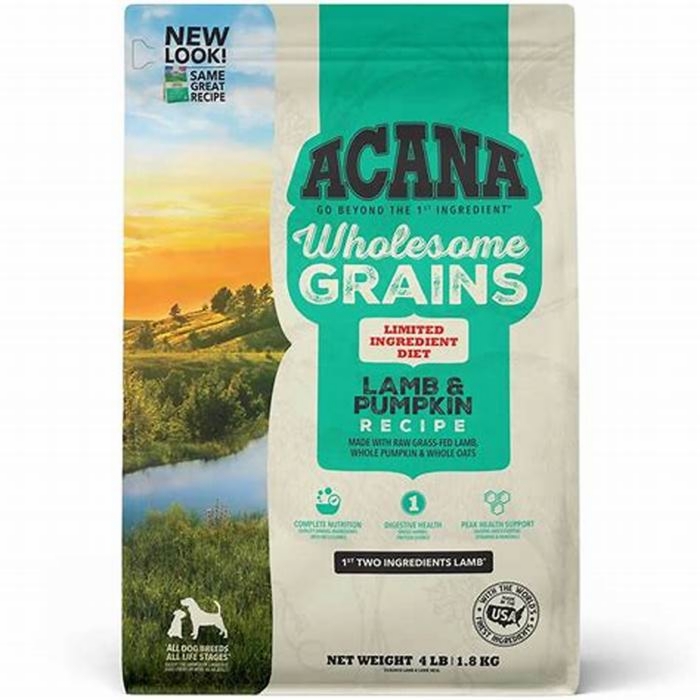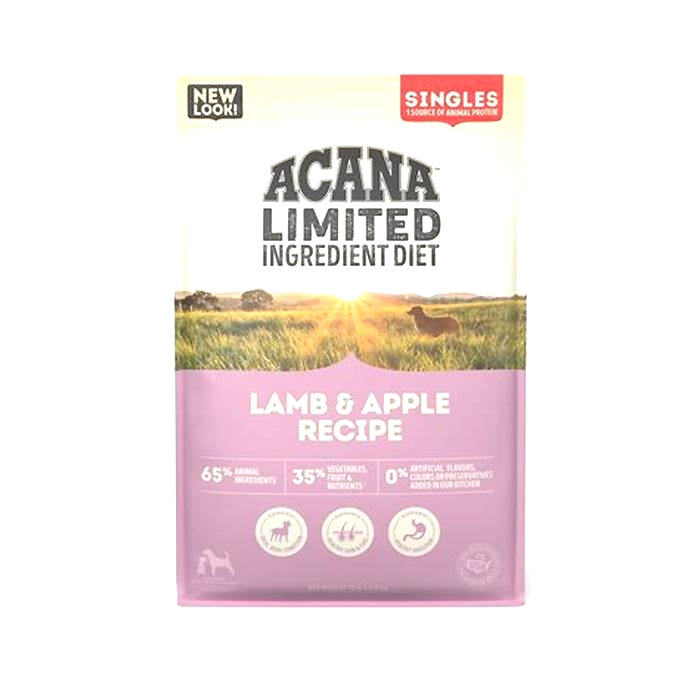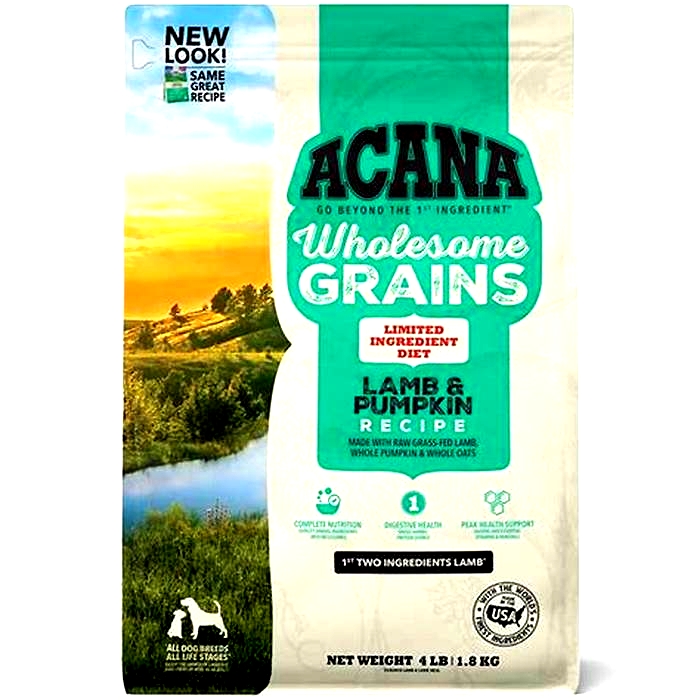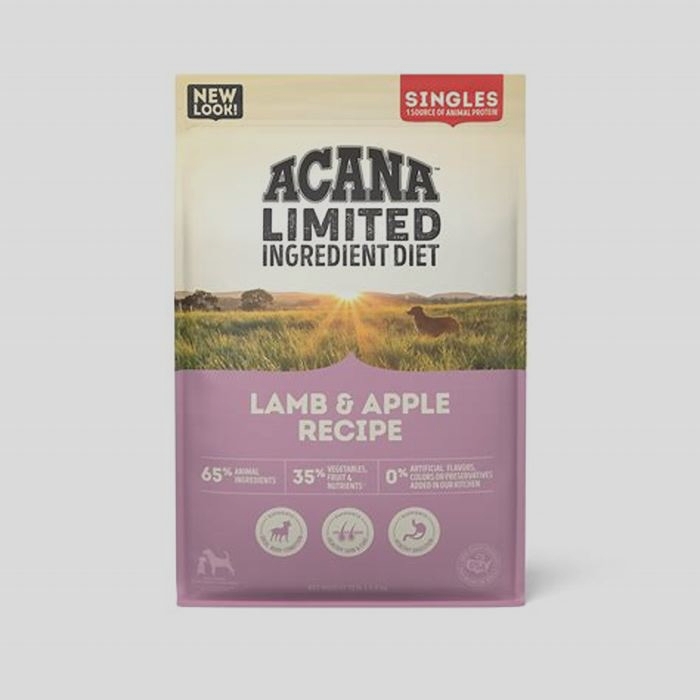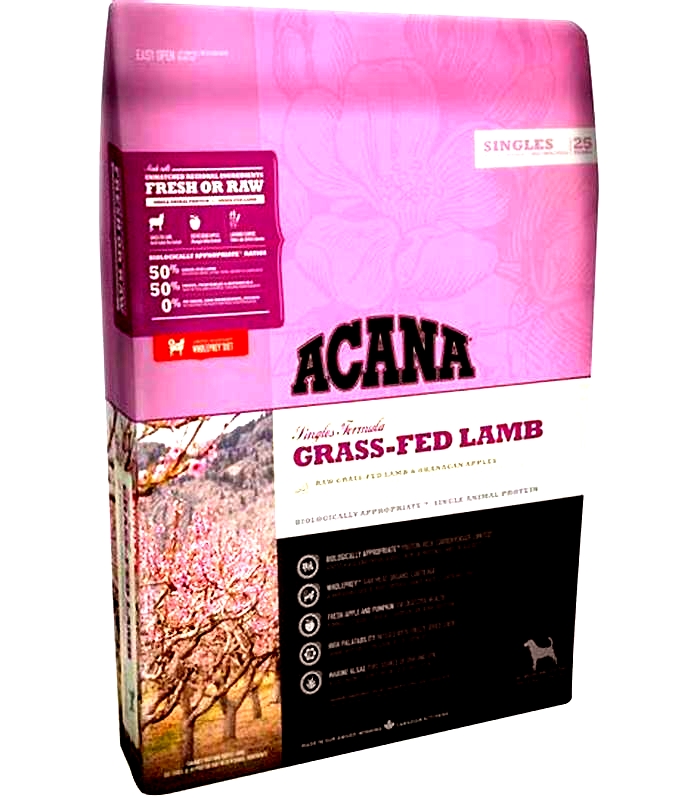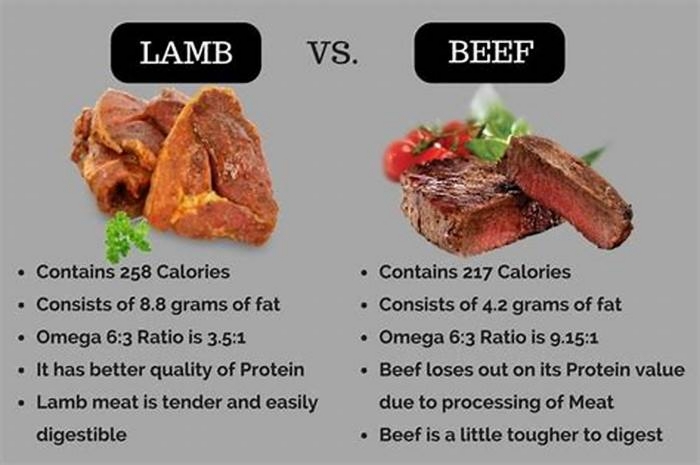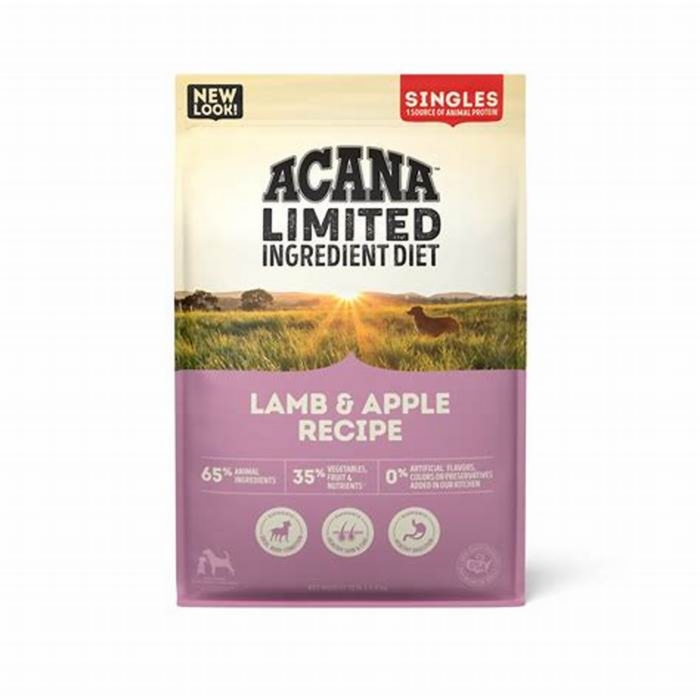The Benefits of Lamb Why Acana s Lamb Based Diets Stand Out
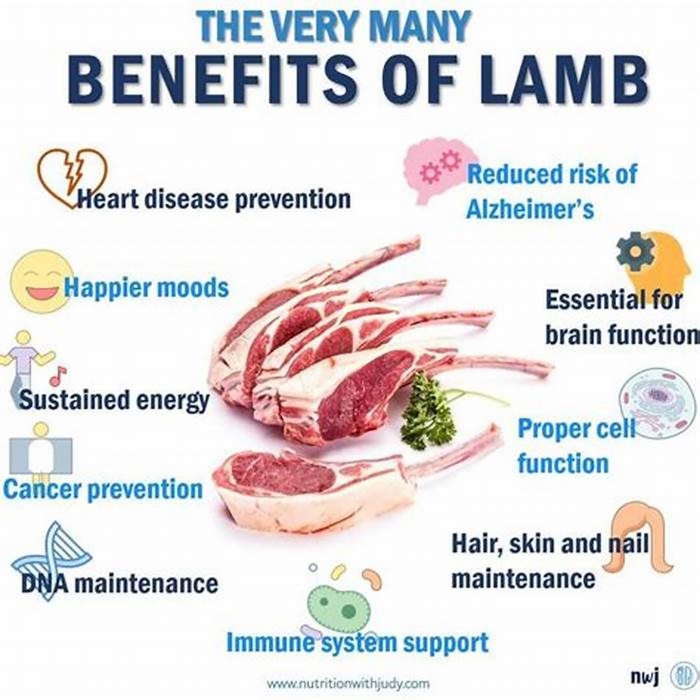
Singles, Lamb with Apple RecipeDry Dog Food
Composition
Raw lamb (21%), lamb meal (18%), raw lamb organs (liver, kidney, tripe) (16%), whole chickpeas, whole lentils, fish oil (5%), fresh apples (4%), dehydrated sweet potato (4%), lentil fibre, sunflower oil, salt, dried kelp, fresh whole pumpkin, fresh whole butternut squash, dried chicory root, whole cranberries, whole blueberries, turmeric, milk thistle, burdock root, lavender, marshmallow root, rosehips.
ADDITIVES (per kg): Technological additives: Tocopherol extracts from vegetable oils: 121 mg, citric acid: 40 mg. Sensory additives: Rosemary extract: 80 mg Nutritional additives: Taurine: 1500 mg, Choline chloride (choline): 700 mg, Zinc proteinate: 160 mg, Copper proteinate: 5.5 mg, Vitamin B1: 75 mg, Vitamin B2: 15 mg, Vitamin B3: 150 mg, Vitamin B5: 45 mg, Vitamin B6: 26 mg, Vitamin B9: 5.25 mg, Vitamin B12: 0.15 mg, Vitamin E: 250 IU. Zootechnical additives: Enterococcus faecium DSM 10663/NCIMB 10415: 1x10^9 CFU.
CALORIE CONTENT (calculated): Metabolizable energy is 3405 kcal/kg (409 kcal per standard 120 g cup) with calories distributed with 32% from protein, 26% from carbohydrates, and 42% from fat. ACANA LAMB WITH APPLE RECIPE dog food is formulated to meet the nutritional levels established by FEDIAF for All Life Stages, excluding growth of all large size dogs (70 lb or more as an adult).
Singles, Lamb with Apple RecipeDry Dog Food
Ingredients
Raw lamb (21%), lamb meal (18%), raw lamb organs (liver, kidney, tripe) (16%), whole chickpeas, whole lentils, fish oil (5%), fresh apples (4%), dehydrated sweet potato (4%), lentil fibre, sunflower oil, salt, dried kelp, fresh whole pumpkin, fresh whole butternut squash, dried chicory root, whole cranberries, whole blueberries, turmeric, milk thistle, burdock root, lavender, marshmallow root, rosehips.
ADDITIVES (per kg): Technological additives: Tocopherol extracts from vegetable oils: 121 mg, citric acid: 40 mg. Sensory additives: Rosemary extract: 80 mg Nutritional additives: Taurine: 1500 mg, Choline chloride (choline): 700 mg, Zinc proteinate: 160 mg, Copper proteinate: 5.5 mg, Vitamin B1: 75 mg, Vitamin B2: 15 mg, Vitamin B3: 150 mg, Vitamin B5: 45 mg, Vitamin B6: 26 mg, Vitamin B9: 5.25 mg, Vitamin B12: 0.15 mg, Vitamin E: 250 IU. Zootechnical additives: Enterococcus faecium DSM 10663/NCIMB 10415: 1x10^9 CFU.
CALORIE CONTENT (calculated): Metabolizable energy is 3405 kcal/kg (409 kcal per standard 120 g cup) with calories distributed with 32% from protein, 26% from carbohydrates, and 42% from fat. ACANA LAMB WITH APPLE RECIPE dog food is formulated to meet the nutritional levels established by FEDIAF for All Life Stages, excluding growth of all large size dogs (70 lb or more as an adult).
Wholesome Grains, Lamb & Pumpkin Recipe, Limited Ingredient DietDry Dog Food
Ingredients
Lamb, lamb meal, oat groats, whole sorghum, lamb liver, whole pumpkin, fish oil, natural lamb flavor, whole oats, ground miscanthus grass, sunflower oil, lamb tripe, salt, taurine, potassium chloride, vitamin E supplement, choline chloride, zinc proteinate, dried kelp, mixed tocopherols (preservative), vitamin D3 supplement, selenium yeast, niacin, thiamine mononitrate, riboflavin, calcium pantothenate, pyridoxine hydrochloride, folic acid, vitamin B12 supplement, copper proteinate, dried chicory root, turmeric, citric acid (preservative), rosemary extract, dried Lactobacillus acidophilus fermentation product, dried Bifidobacterium animalis fermentation product, dried Lactobacillus casei fermentation product.
METABOLIZABLE ENERGY: 3370 kcal/kg (371 kcal per standard 8 oz cup), with 29% from protein, 28% from carbohydrates, and 43% from fat.
ACANA LAMB & PUMPKIN is formulated to meet the nutritional levels established by the AAFCO Dog Food Nutrient Profiles for All Life Stages except for the growth of large breed dogs (70lbs or more as an adult)
10 Health Benefits of Lamb Meat (and Complete Nutrition Profile)
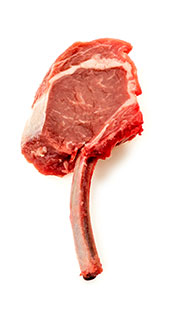 Lamb is a common type of red meat.
Lamb is a common type of red meat.
Due to its impressive nutrition profile, it is perhaps the healthiest commonly available meat.
This article will analyze the complete nutritional values of lamb.
Additionally, we will examine the science-backed health benefits of lamb to show why it is one of the healthiest foods around.
What is Lamb?
Lamb refers to the meat of a sheep in its first year.
The meat from these animals is usually produced when the sheep is between 1 and 12 months old.
Lamb is a kind of red meat because it has a high myoglobin content, an iron-rich protein found in the muscle of animals.
Myoglobin contains heme, which is a pigment that gives meat its red color (1).
All meat and poultry contain myoglobin, but beef and lamb contain much larger concentrations hence their classification as red meat.
Lamb is a nutrient-dense food, and it is rich in protein, vitamins and essential minerals.
Key Point:Lamb means the meat of a sheep under one year of age. It is a nutritious form of red meat.
The Difference Between Lamb and Mutton
Before we get started looking at the health benefits, many people wonder how lamb compares to mutton nutritionally.
The definition is quite simple;
- Lamb: Meat from a sheep under 12 months old.
- Mutton: Meat from a sheep over the age of one year.
While this all sounds very simple, there are further key differences between the two types of meat.
Lamb
Lamb meat enjoys far greater popularity than mutton due to its tenderness and milder flavor.
Studies show that the texture of lamb deteriorates with advancing age. As a result, some farmers produce lamb from as young as one month old (2).
Mutton
As sheep eat large quantities of grass throughout their life, mutton meat becomes very fatty and imparts a much stronger flavor.
Additionally, the meat is chewier and doesnt have the tenderness of lamb.
However, some people have a taste preference for the higher fat content and stronger flavor.
Key Point:Lamb is meat from a young sheep while mutton comes from older animals. Lamb is more tender, but has a lower fat content compared to mutton.
Nutrition Facts
The nutritional value of lamb is impressive; it contains a range of beneficial nutrients including protein, healthy fats, vitamins and minerals.
The tables below show the full range of nutrients in cooked domestic lamb (leg shank) per 100 grams (3).
Calories and Macronutrients
| Macronutrient / Calories | Amount (Grams / Kcal) |
| Calories | 243 kcal |
| Carbohydrate | 0 g |
| Fiber | 0 g |
| Sugar | 0 g |
| Fat | 13.5 g |
| Saturated Fat | 5.6 g |
| Monounsaturated Fat | 5.7 g |
| Polyunsaturated Fat | 1.0 g |
| Omega-3 | 190 mg |
| Omega-6 | 730 mg |
| Protein | 28.4 g |
As shown above, lamb is a mixture of fat and protein.
Lamb fat mainly comes from equal parts saturated and monounsaturated fat. Among the fatty acids, oleic acid is the most predominant (4).
For those who are unaware, this monounsaturated fatty acid is also the primary fat in olive oil (5).
Compared to most meat, lamb also has a much higher omega-3 content.
However, as a domestic American lamb, the meat shown in the table is likely grain-finished.
Opt for pasture-raised lamb for an even better provision of omega-3.
Vitamins
Here is the vitamin profile; as shown, lamb is an excellent source of B vitamins particularly vitamin B12.
| Vitamin | Amount (Grams / % RDA) |
| Vitamin B12 | 38% |
| Vitamin B3 | 27% |
| Vitamin B2 | 11% |
| Vitamin B5 | 6% |
| Vitamin K2 | 5% |
| Vitamin B6 | 5% |
| Folate | 4% |
| Vitamin B1 | 3% |
| Vitamin E | 1% |
Minerals
Lamb is incredibly rich in minerals, especially iron, phosphorus, selenium and zinc.
| Mineral | Amount (Grams / % RDA) |
| Zinc | 51% |
| Selenium | 44% |
| Phosphorus | 17% |
| Iron | 12% |
| Potassium | 7% |
| Copper | 6% |
| Magnesium | 5% |
| Sodium | 3% |
| Calcium | 2% |
| Manganese | 1% |
Key Point:Lamb has a very healthy nutrition profile and it contains a wide variety of essential nutrients. It is a significant source of B vitamins, zinc and selenium.
10 Health Benefits of Lamb Meat
Aside from the nutrient profile, lamb has many other nutritional benefits.
Here are ten good reasons to eat lamb.
1. Lamb Contains L-Carnosine
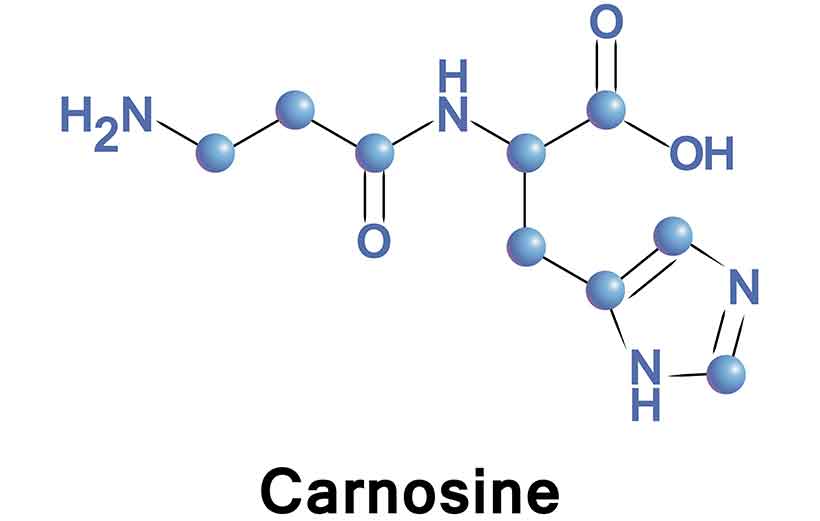
L-Carnosine is a compound that contains two amino acids (proteins) bonded together; beta-alanine and histidine.
Only certain foods contain carnosine in high amounts, and lamb is one of these.
Per 100 grams, lamb contains on average 400mg of carnosine, which is slightly higher than beef (365mg) (6).
L-Carnosines Health Benefits
Firstly, carnosine is classed as a non-essential nutrient because our bodies can make it internally.
However, recent research is showing that higher amounts of carnosine from external sources may offer additional health benefits.
Among these, carnosine appears to have anti-atherosclerotic effects, meaning that it may help to protect against cardiovascular disease (7, 8).
Notably, carnosine also helps to reduce the glycation of sugars and proteins in our body.
Glycation leads to the formation of advanced glycation end products (AGEs).
Unfortunately, AGES are harmful compounds which directly cause inflammation and oxidative stress, and they are believed to be one of the keys to the aging process (9, 10).
Key Point:Lamb is among the best dietary sources of carnosine, a healthy compound that may have powerful health-protective properties.
2. Lamb is a Significant Source of Complete Protein
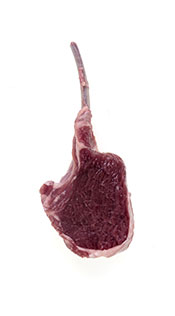
One of the biggest positives from eating lamb is the protein content.
Lamb is extremely rich in protein, and depending on the cut it contains anywhere between 25 30 grams per 100 grams (11, 12, 13).
While it is common knowledge that lamb is an excellent source of protein, not all protein is made the same.
In other words; the efficiency by which our body can use protein differs depending on the specific food and the amino acids it contains.
On the positive side, lamb contains every amino acid, and we can, therefore, class it as a complete protein.
This completeness means that our body can use lamb protein more efficiently than incomplete proteins in plant foods.
Protein is incredibly important for our health, and it encourages lean muscle mass, the growth and repair of cells, and higher levels of satiety (14, 15, 16).
Key Point:Lamb contains a significant amount of high-quality protein.
3. Lamb Is Incredibly Nutrient Dense
While some people like to judge food based on how many calories it contains, the caloric load says little about the foods relative health merits.
The best measurement of the health properties of a particular food is nutrient density.
Lamb passes the nutrient-density test with flying colors, and here is a quick summary of why;
- Lamb contains large amounts of healthy fat, including more omega-3 than most land animals and high levels of oleic acid.
- High concentrations of bio-available, highly digestible protein.
- A substantial amount of vitamins and minerals; particularly B vitamins and zinc.
- A range of beneficial compounds including creatine, glutathione, conjugated linoleic acid, carnosine and taurine.
Key Point:Lamb contains a large range of beneficial compounds, and as a total package it offers a lot.
4. A Surprising Source of Omega-3 Fatty Acids
In the modern world, most people are consuming too much omega-6 and not enough omega-3. This issue is important because omega-3 fatty acids have an anti-inflammatory effect, while omega-6 is pro-inflammatory.
Providing these two essential fatty acids are relatively balanced, they are both useful and beneficial. However, some people are now eating a diet that is approaching 20:1 in favor of omega-6 to omega-3 (17).
Removing omega-6 vegetable oils such as soybean oil is a great way to change this. Additionally, consuming omega-3 fatty acids from seafood (especially oily fish) helps us to get more omega-3.
However, land animals can also be rich in omega-3.
This is especially the case for animals raised on pasture. As one such animal, lamb tends to be an excellent source of omega-3.
In pasture-raised lamb, the levels of omega-3 are higher than grain-finished animals.
As an example, 100 grams of grass-fed lamb rib contains 580 mg of omega-3 and 750 mg of omega-6; nearly a 1:1 ratio (18).
Key Point:Lamb meat especially pasture-raised is rich in omega-3 fatty acids.
5. An Important Source of Heme Iron
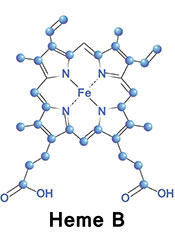
Many different foods contain iron and it is present in everything from spinach and kale to bananas and tomatoes.
However, just as the digestibility of protein differs, not all iron is made the same.
When it comes to digestion and absorption, heme iron is king.
In fact, we can absorb approximately 15-35% of heme iron (found in animal foods), but this absorption rate drops to 10-15% for non-heme sources of iron (plant foods) (19).
It is unfortunate to see the rise of iron-deficiency anemia.
Over the period between 2004 and 2013, iron-deficiency anemia rates in the US population nearly doubled to 5.6%. During the same decade, red meat consumption fell by 19% (21, 22).
Importantly, lamb contains a rich source of heme iron in amounts similar to other red meat such as beef.
Key Point:Lamb contains large amounts of heme-iron, which is an important nutrient in the face of rising iron-deficiency anemia.
6. Lamb Contains a Significant Amount of Creatine
Creatine will be well known to anyone with interest in working out and/or sporting performance.
Markedly, creatine can help to boost muscular endurance, strength and potentially muscle mass (23).
While creatine supplements are very popular, this compound also occurs naturally in various foods.
Red meat is the most substantial dietary source of creatine and lamb contains approximately 300-500 mg per 100 grams (24).
Although this is not close to the same level as creatine supplement dosages (3 5 grams per day), it should still have a physiological benefit especially for those eating higher amounts of lamb and beef.
Key Point:Lamb contains beneficial amounts of creatine, a compound that can help to improve sporting performance.
7. Lamb is a Source of the Master Antioxidant Glutathione
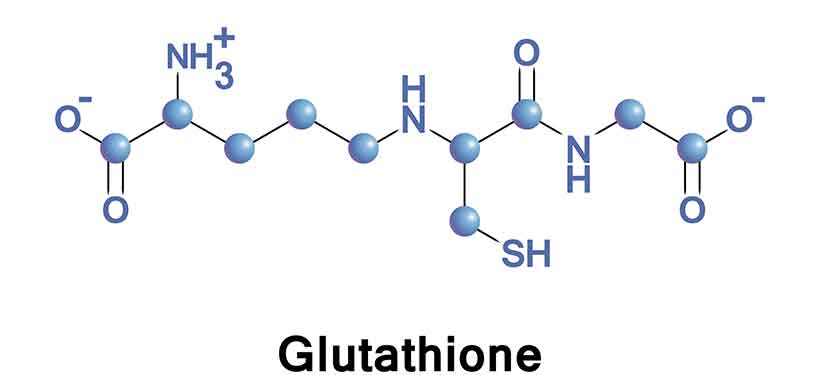
People often refer to glutathione as the master antioxidant because of the critical role it plays in protecting our health and our internal antioxidant defense systems (25).
We cannot read too much into this since there is no clinical research on humans, but higher glutathione levels track with a longer lifespan in animal studies (26, 27).
Notably, our body makes the glutathione compound internally from the amino acids cysteine, glutamic acid and glycine.
However, research suggests that consuming more exogenously (from outside sources; i.e. food) could have advantages.
On this note, a further health benefit of lamb is that it contains glutathione (28).
Also, it contains all three amino acids that our body requires to synthesize glutathione internally.
Key Point:Lamb contains glutathione and it also provides all the essential prerequisites for our body to make its own glutathione.
8. Lamb Contains Conjugated Linoleic Acid (CLA)
Lamb contains a source of the natural trans-fatty acid CLA.
Firstly, dont worry about the name trans fat because the naturally occurring version found in animal foods is much different from synthetic trans-fat (29).
In fact, it may even have some health benefits.
For instance, a meta-analysis of 18 controlled trials demonstrates that supplementing with isolated CLA produces a modest fat loss in humans(30).
Furthermore, research shows that people with higher tissue levels of CLA have a reduced risk for myocardial infarction (heart attack) (31).
However, correlation does not necessarily equal causation. To illustrate this point, the people with higher levels of CLA were likely consuming more meat and dairy (and probably less refined carbohydrate).
In other words, it is difficult to pinpoint precisely what is lowering the risk.
Either way, lamb meat is richer in CLA than any other meat and contains approximately 4 19.0 mg CLA per gram of fat content.
By comparison, beef typically contains 1.2 4.0 mg while pork and poultry contain less than 1.0 mg (32).
Key Point:Lamb is the single biggest dietary source of CLA.
9. A Source of Healthy Fats
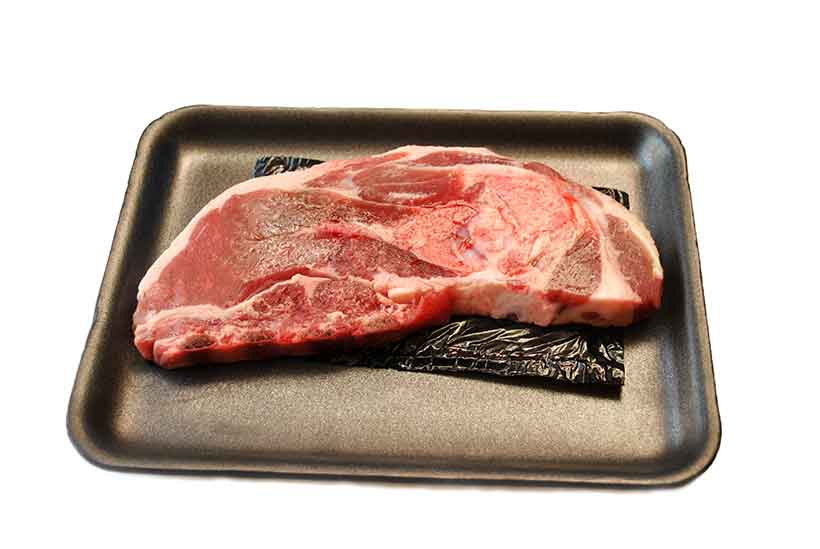
These kinds of health benefit lists generally do not mention fat.
After years of health authorities demonizing dietary fat, that is not really a big surprise.
However, lets give fat the credit it deserves; good fat is an essential and healthy part of the human diet.
Furthermore, two specific fatty acids in lamb are very beneficial for us;
- Omega-3: Lamb meat from animals raised on pasture has similar levels of anti-inflammatory omega-3 fatty acids as some fish (18).
- Oleic acid: This monounsaturated fatty acid is one of the most evidence-based fats and it is widely known as the heart healthy fat in olive oil. Research consistently links oleic acid to lower levels of inflammation and better health markers (33, 34, 35, 36).
Key Point:Lamb contains a variety of natural, healthy fats, with oleic acid and omega-3 being particularly notable.
10. Lamb is Tasty!
This one is not really a health benefit, but it is always challenging to enjoy supposedly healthy (flavorless) low-fat products.
On the other hand, lamb genuinely is nutrient-dense and a healthy food. It is doubtful that anyone would complain about the taste of it.
Put simply; lamb is one of the tastiest (and healthiest) foods in the world.
Are There Any Concerns About Lamb Meat?
There are several concerns about lamb meat, but nothing too worrying.
1. Red Meat and Cancer Risk
To start with, a range of epidemiological (observational) data suggests that red meat may increase the risk of colorectal cancer.
However, there isnt any strong causative evidence for this, and there are many confounding factors: see here for a full analysis.
2. Lamb Contains Cholesterol
Some people still worry about the cholesterol content of animal products due to the decades of warnings against dietary cholesterol.
However, rigorous systematic reviews and meta-analyses have shown that dietary cholesterol is not a nutrient of concern (37, 38).
3. Affordability
Depending on location, lamb can be reasonably priced or it can be very expensive.
As a result, affordability can be an issue.
If this is an issue, it could be worth looking at the cheaper cuts of lamb such as neck, shoulder, or even ground meat.
Final Thoughts
Lamb is a very nutritious food that is full of protein, healthy fats and a wide range of micronutrients.
All in all, lamb is possibly the best choice of meat for those looking for the most health benefits.


